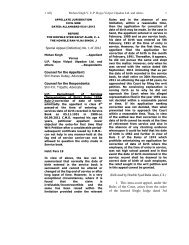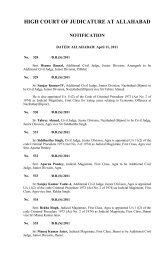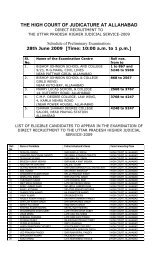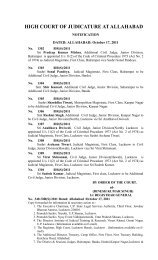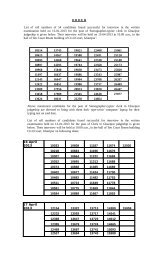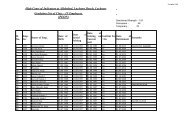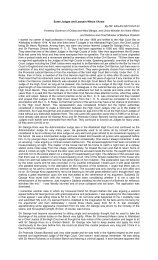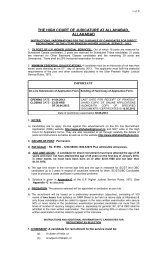Apr - High Court of Judicature at Allahabad
Apr - High Court of Judicature at Allahabad
Apr - High Court of Judicature at Allahabad
Create successful ePaper yourself
Turn your PDF publications into a flip-book with our unique Google optimized e-Paper software.
1 All] Gopal Singh Visharad V. Jahoor Ahmad and others 393<br />
"Expression-the action <strong>of</strong> expressing<br />
something. A look on someone's face th<strong>at</strong><br />
conveys a particular emotion. A word or<br />
phrase expressing an idea. . . ."<br />
36. The term "expression" in defined<br />
in P. Raman<strong>at</strong>ha Aiyer's "The Law<br />
Lexicon-The Encyclopaedic Law<br />
Dictionary with Legal Maxims, L<strong>at</strong>in<br />
Terms, Words and Phrases" 2nd Edition<br />
Reprint 2007 <strong>at</strong> page 687:<br />
"Expression. A word, phrase or form<br />
<strong>of</strong> speech; the act <strong>of</strong> manifesting by action<br />
or language."<br />
37. The distinction between the<br />
"judgment" and "decree", therefore, is th<strong>at</strong><br />
the judgment contains reasons as well as<br />
the conclusions there<strong>of</strong> but the decree<br />
contains formal expression <strong>of</strong> an<br />
adjudic<strong>at</strong>ion conclusively determining<br />
right <strong>of</strong> parties with regard to all or any <strong>of</strong><br />
the m<strong>at</strong>ter in controversy in the suit. The<br />
phrase "all m<strong>at</strong>ters in controversy in the<br />
suit" would cover the ultim<strong>at</strong>e conclusion<br />
and adjudic<strong>at</strong>ion made by the <strong>Court</strong> which<br />
should form part <strong>of</strong> decree as it is this part<br />
which has to be normally put on for<br />
execution as provided in Part II <strong>of</strong> CPC. It<br />
talks <strong>of</strong> execution <strong>of</strong> "decree" and not <strong>of</strong><br />
the judgment. It is for this reason Section<br />
33 provides th<strong>at</strong> after the case has been<br />
heard, the <strong>Court</strong> shall pronounce judgment<br />
and on such judgment a decree shall<br />
follow. It is the conclusive determin<strong>at</strong>ion,<br />
therefore, which must be expressed<br />
formally in the decree and not the<br />
conclusions on various grounds/ issues<br />
considered by the Judge in judgment. In<br />
the context we are <strong>of</strong> the view th<strong>at</strong><br />
adjudic<strong>at</strong>ion determining conclusively<br />
rights <strong>of</strong> parties by the <strong>Court</strong>, which<br />
obviously being the majority decision<br />
would/should contain the part <strong>of</strong> decree<br />
and not just and mere "expression" given<br />
by all the Judges.<br />
38. The suggestion th<strong>at</strong> decision <strong>of</strong><br />
Judge constituting minority, if not made a<br />
part <strong>of</strong> the decree, such Judge may not sign<br />
the decree, would not apply where the<br />
decree is being prepared by the <strong>Court</strong> in its<br />
original jurisdiction as a trial court. The<br />
decree may be signed by all the Judges<br />
constituting the Bench. It is necessary to<br />
make the things clear unequivocally to<br />
parties concerned. In this case c<strong>at</strong>egorical<br />
and specific majority opinion on various<br />
aspects between Judges has to be g<strong>at</strong>hered<br />
since the observ<strong>at</strong>ions and expressions<br />
have been made with reserv<strong>at</strong>ions,<br />
references etc. To our mind, it means when<br />
an adjudic<strong>at</strong>ion is made and it conclusively<br />
determines rights <strong>of</strong> parties, only th<strong>at</strong> part<br />
should form the contents <strong>of</strong> decree. The<br />
majority judgment finds th<strong>at</strong> plaintiff is not<br />
entitled to any relief or Suit-1 is to be<br />
dismissed.<br />
39. The extraordinary situ<strong>at</strong>ion<br />
demands extra ordinary procedure and<br />
methods. We initially, therefore, were<br />
inclined to hold th<strong>at</strong> decision <strong>of</strong> Sudhir<br />
Agarwal, J. constituting minority opinion<br />
may be made part <strong>of</strong> the decree but we<br />
ultim<strong>at</strong>ely after due diligence over the<br />
m<strong>at</strong>ter decided to follow a method so th<strong>at</strong><br />
things may be apparent and clear to all<br />
parties. The way in which we intend to<br />
proceed is not inconsistent with any<br />
specific provision with respect to<br />
prepar<strong>at</strong>ion <strong>of</strong> decree contained in CPC or<br />
<strong>High</strong> <strong>Court</strong> Rules.<br />
40. We, therefore, direct th<strong>at</strong> the<br />
decree <strong>of</strong> Suit-1 should express <strong>Court</strong>'s<br />
formal expression <strong>of</strong> adjudic<strong>at</strong>ion<br />
conclusively determining the rights <strong>of</strong><br />
parties with regard to all the m<strong>at</strong>ters in




